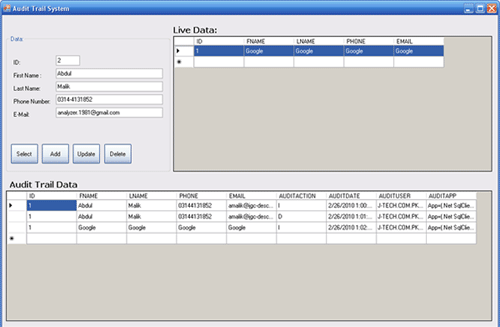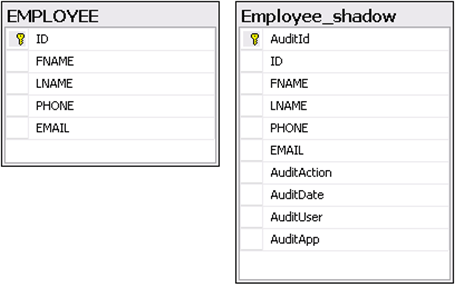
Introduction
There are multiple reasons to have an Audit trail System in your application. Some companies have to do it because of their rigid / un-professional enviroment, such as JGC-DESCON ENGINEERING PVT. LTD. But on the other end it is very useful for debugging purpose. It shows you what was in your database at any point in time.}
In this article I will explain the method I prefer for implementing an audit trail. Next, I will introduce a script to automate the implementation of the audit trail in the database.
Audit Trail With Triggers
So how to implement an audit trail? Different visions exist. The one I prefer is to use a shadow table for each table that exists in the database. Every time a record is inserted, updated or deleted in a table, the record is also inserted in the corresponding shadow table. For inserting the record in the shadow table too, I use triggers on the original table that will fire whenever something happens.
Let's make this clear with a small example.

On the left side, you see the structure of a table called Employee containing five columns. I refer to this table as the base table. On the right, you see the shadow table for this table. The shadow table contains all columns from the Employee table, plus some extra columns:
-
AuditId: This the primary key of the shadow table. It is an identity field.
-
AuditAction: This is a one letter code to indicate the kind of operation. Values are I, U or D, for insert, update and delete respectively.
-
AuditDate: The date and time when the action occurred. The default value is set to getdate(), an SQL function that returns the current date and time.
-
AuditUser: The user who performed the action. The default value is set to suser_sname(), an SQL function that returns the user name of the user currently connected.
-
AuditApp: The application that was used. The default value is set to (('App=('+rtrim(isnull(app_name(),'')))+') '). This allows you to tell which application was used to modify the data, e.g. App=(Microsoft SQL Server Management Studio Express).
To fill up the shadow table, I define triggers on the Employee table. We need three triggers: one for inserts, one for updates, and one for deletes. The code for the insert action is shown below. Those for updates and deletes are similar.
CREATE TRIGGER tr_Employee_Insert ON dbo.Employee
FOR INSERT AS
INSERT INTO Employee_shadow(ID, FNAME, LNAME, PHONE, EMAIL,AuditAction) SELECT ID, FNAME, LNAME, PHONE, EMAIL,'I' FROM employee
The columns that are filled up by the trigger are only the data columns from the base table (ID, FNAME, LNAME, PHONE, EMAIL,AuditAction) and the AuditAction column. All other columns in the shadow table (AuditId, AuditDate, AuditUser and AuditApp) are filled up by their default value definition.
So what are the strengths and weaknesses of this approach? Let's start with the strengths:
-
It completely separates the current data from the audit trail. The old values are no longer in the base table but in the shadow table. There are no soft deletes, where deleted records are flagged as being deleted instead of being actually deleted.
-
It can easily be implemented on existing databases. If originally you did not foresee audit trailing, you can add it afterwards. The only thing you need to do is add the triggers on the base tables and create the shadow table. No changes have to be made to stored procedures or applications working with your database.
-
It always triggers. E.g. if you connect to your database through Enterprise Manager and you modify the data by hand, the triggers fire and the shadow table is updated accordingly.
The method also has some drawbacks:
-
The entire record is copied to the shadow table, including the columns that were not changed. In our example, if you change the firstname of a user in the base table, the lastname is also copied to the shadow table although it did not change. Hence, the shadow table will take up more space than strictly needed.
-
A trigger cannot be used on all column data types. Text, Ntext, and Image are not supported. The reason is that they are not stored in the record itself. The record only holds a pointer to the data. In SQL 2005, the timestamp is not supported either.
-
The number of tables doubles, although I personally don't find this an objection.
-
The audit trail is on a table level instead of on an action level. If during a single save operation in your application multiple tables in your database get updated, there is no link between the different transactions that took place on the different tables. The only thing that links them together is that they occurred at (almost) the same moment and by the same user.
The Audit Trail Generator Script
If you have 50 tables in your database, adding an audit trail using the method just described means adding another 50 tables and creating 150 triggers. This is why I have created the audit trail generator. It saves time and avoids typo errors. See the link on top of this article to download the code.
The audit trail generator is written as a stored procedure. Hence, you don't need any other tools.
The stored procedure takes four arguments:
-
@TableName: The name of the table to which you want to add an audit trail, e.g. users
-
@Owner: The owner of the table. The default value is dbo
-
@AuditNameExtention: The extension you want for the shadow table name. E.g., if you set it to _shadow, the audit table for users will be calledusers_shadow. The default value is _shadow
-
@DropAuditTable: A bit to specify if the shadow table can be dropped. If 1, the existing audit table will be dropped and recreated. Of course, you lose all data in there. This is especially useful when you are still in development, but you may want to do this on a production system. The default value is 0.
The stored procedure will discover the columns in the original table by querying the system tables of SQL Server. These system tables are used by SQL Server itself to store the structure of the tables. The query to get all info about the table is shown below.
SELECT b.name, c.name as TypeName, b.length,b.isnullable, b.collation, b.xprec, b.xscale
FROM sysobjects a
inner join syscolumns b on a.id = b.id
inner join systypes c on b.xtype = c.xtype and c.name <> 'sysname'
WHERE a.id = object_id(N'Employee')
and OBJECTPROPERTY(a.id, N'IsUserTable') = 1
ORDER BY b.colId
The image below shows the results if we launch this query for our Employee table.

The remainder of the stored procedure loops over the result of this query using a cursor, and dynamically builds up the SQL statements in a string to create the shadow table and to add the triggers to the original table. These statements are then executed with the EXEC command. I will not go into the details of it, since it is straight forward.
Using the Script
The script is a stored procedure, so using it means calling the stored procedure. In its simplest form, you only need to set the @TableName parameter because for all other parameters, default values have been specified. The following statement can be launched from a query window.
EXECUTE GenerateAudittrail 'Users'
The following example shows what it looks like if all parameter values are specified.
EXECUTE GenerateAudittrail 'Users', 'dbo','_shadow', 0
The script is very handy to quickly create a shadow table for a given database table. However, it was not designed to modify a shadow table to reflect changes to the corresponding base table. In this case, it can only drop the shadow table, losing all records in it, and recreate it. Set the @DropAuditTable to 1 to force dropping and recreating the shadow table.